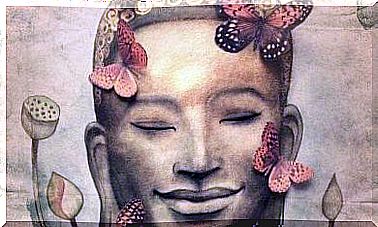The 4 Types Of Intuitive Thinking

Intuitive thinking remains an enigma for science. Still, it has been possible to advance and better understand that expression of the brain that is fascinating and, at the same time, unpredictable. It is halfway between emotion and reason. That is why it is so mysterious.
It is worth saying that intuitive thinking is one that allows us to understand reality instantly, without the mediation of logic or analysis. Neither does he use verbal language, but is based on signs and sensations. Many times, in fact, it goes against what we might call “reasonable”.
According to science, intuitive thinking occurs in an area of the brain near the pineal gland . That is, between the eyebrows, just in the middle of the forehead. Intuition is not controlled voluntarily, but appears as a kind of “inspiration.” In practice, it works. It is what some call “clinical eye” in doctors, or being “visionary” in other fields.
Intuitive thinking and science
The subject of intuitive thinking has lent itself to much speculation. As it is closely associated with emotions, it is not so easily verified. Sometimes a person simply suggests himself and makes what he “sensed” was going to happen to happen.
However, science has taken over this issue and some progress has been made in this regard. In the framework of the Brain Evolution and Behavior program of the National Institute of Mental Health of the United States, directed by Professor Paul Mac Lean, the subject has been studied.
According to his research, intuitive thinking originates in the neocortex . This section of the brain combines elements from both hemispheres. Although the exact mechanisms by which it operates are not known, it is estimated that it is an instantaneous processing of knowledge, experiences and reading of evidence, which results in a correctness in the face of reality.
The four types of intuitive thinking
Intuition has always been spoken of as a kind of “spark” that arises and illuminates everything. Albert Einstein claimed that his studies had a high component of intuition. However, it is the artists who most intensely make use of this interesting function.

It has been postulated that there are four types of intuitive thinking. These are:
- Intuitive emotional thinking. It corresponds to the ability to suddenly detect the main personality traits of others, or the emotional state in which they are. You can see who they are or how they are, without words.
- Intuitive mental thinking. It has to do with finding the answer to a problem immediately, without analyzing it. It is very common in those who have jobs that require very quick decisions, such as firefighters or explosives experts.
- Intuitive psychic thinking. It refers to the ability to choose the best way to overcome or overcome a personal difficulty, without further intellectual data in this regard. Also to perceive social or work atmospheres.
- Intuitive spiritual thinking. It corresponds to the states of “enlightenment” or to “revelations.” They are more an experience, than a fact. Buddhists refer the most to this form of intuition, which has a mystical character.

Can we develop intuition?
In our western culture it is very difficult to hear that voice of intuition. We are all crossed by rationalism and it is very difficult for us to give credit to what does not pass through logic, or shows some type of empirical support. We defend ourselves a lot from anything that is not clearly reasonable. That is why sometimes it is very difficult for us to intuit.
In the same way, lack of confidence in ourselves causes intuitive thinking to be blocked. If we doubt our subjective experiences a lot, every intuition will be immediately contaminated by that doubt. Instead of leading us to a certainty, or intuition itself, it generates confusion and apprehension.
The best way to develop intuition, therefore, is to let ourselves flow more freely. A good strategy is to take note of the first thing that comes to mind, in front of a certain reality, before this is processed by reason. Letting it out as we perceive it, as in a kind of automatic writing exercise.
Then we can review those notes and assess whether that initial impression had any validity. If within it there were reasonable elements that effectively aimed to understand or solve a situation correctly, we speak of intuition. This simple exercise might surprise us a lot.









